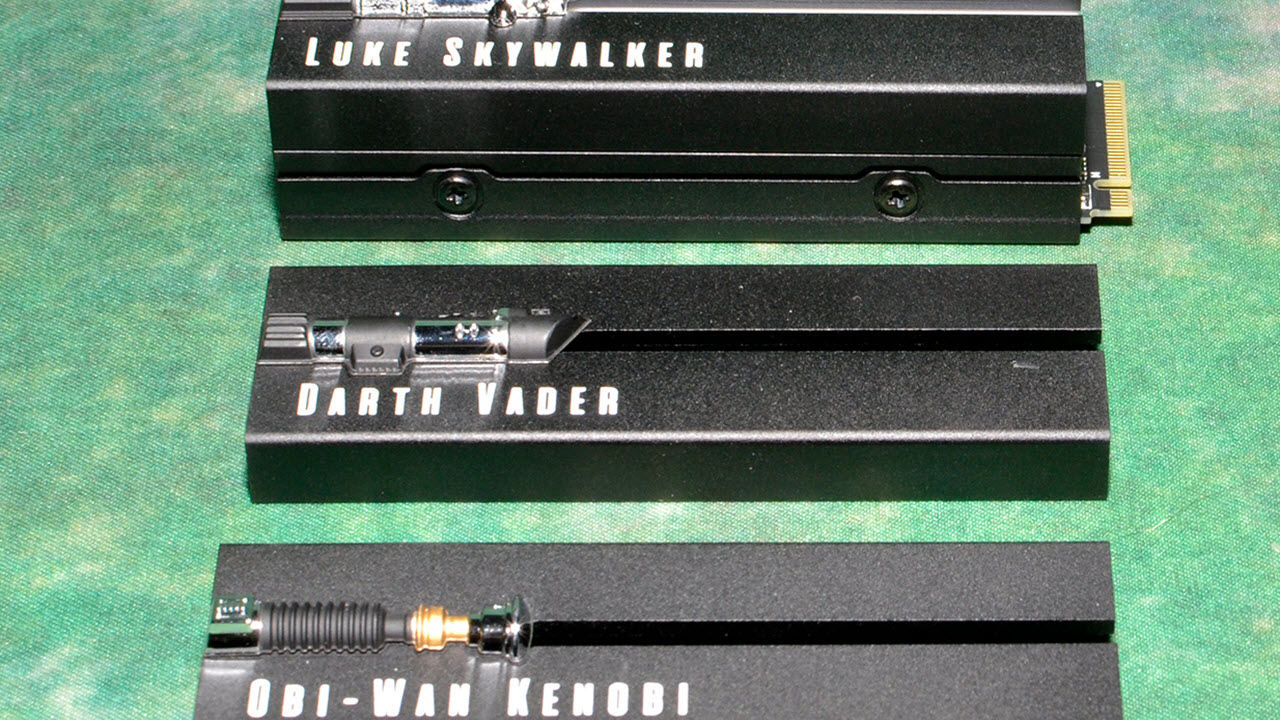
The Seagate Lightsaber Collection Special Edition FireCuda is the SSD to get for Star Wars fans. A sleek heatsink and switchable heroic lightsaber faceplates are combined with addressable RGB LEDs for an unmistakable look. It’s a potential showpiece for your build, and you can control the lighting through software to match your specific aesthetic. The drive itself is nothing special, but it’s fast enough for any sort of use and has Seagate’s comforting three-year data recovery service to boot, making it a contender for our list of Best SSDs.
Underneath the Seagate Lightsaber FireCuda, as we will henceforth call it, is essentially Seagate’s older FireCuda 530. This drive is known for good performance in sustained workload and is a high-end PCIe 4.0 SSD with a high endurance (TBW) rating. Seagate’s warranty comes with one attempt at data recovery, and they also support the drive with its SeaTools software. That means this drive is a safe bet, even if it’s not the fastest. The challenge would be in acquiring one!
The Lightsaber FireCuda is meant to be shown off, which means it’s intended for desktop use. It arrives with three changeable faceplates and a long ARGB connector cable. The latter can be a pain to work with, depending on your predilections for cable running. The heatsink is functional and designed by EKWB, which matches well with the higher sustained performance. Otherwise, this is a standard FireCuda 530, which is among the more consistent SSDs based on Phison’s E18 SSD controller.
Specifications
The Seagate Lightsaber FireCuda is available at 1TB and 2TB, priced currently around $159.99 and $239.99, respectively. It can be difficult to find these drives, and the price is fairly high for what you get, but if you want the specific aesthetic, it’s not too bad. The drive is fastest at 2TB, hitting 7,300 MBps / 6,900 MBps for sequential reads and writes and 1M / 1M IOPS for random reads and writes.
Seagate warranties this drive for five years and 1,275TB of writes per TB of capacity, which is pretty high. It is not recommended to use the TBW rating when selecting a drive, as even the standard 600TB per TB is an immense amount of writes. Seagate also backs the SSD with its three-year Rescue Data Recovery Services which is nice, although probably more useful for hard drives.
Software and Accessories

The Lightsaber FireCuda comes with the standard manuals and packaged content, including a notice of its Rescue Data Recovery Services. It’s also possible to download SeaTools on Seagate’s site for Windows, Linux, and in a bootable format, which is nice to see. The SeaTools application offers standard monitoring and tools for Seagate’s HDDs and SSDs.
A Closer Look
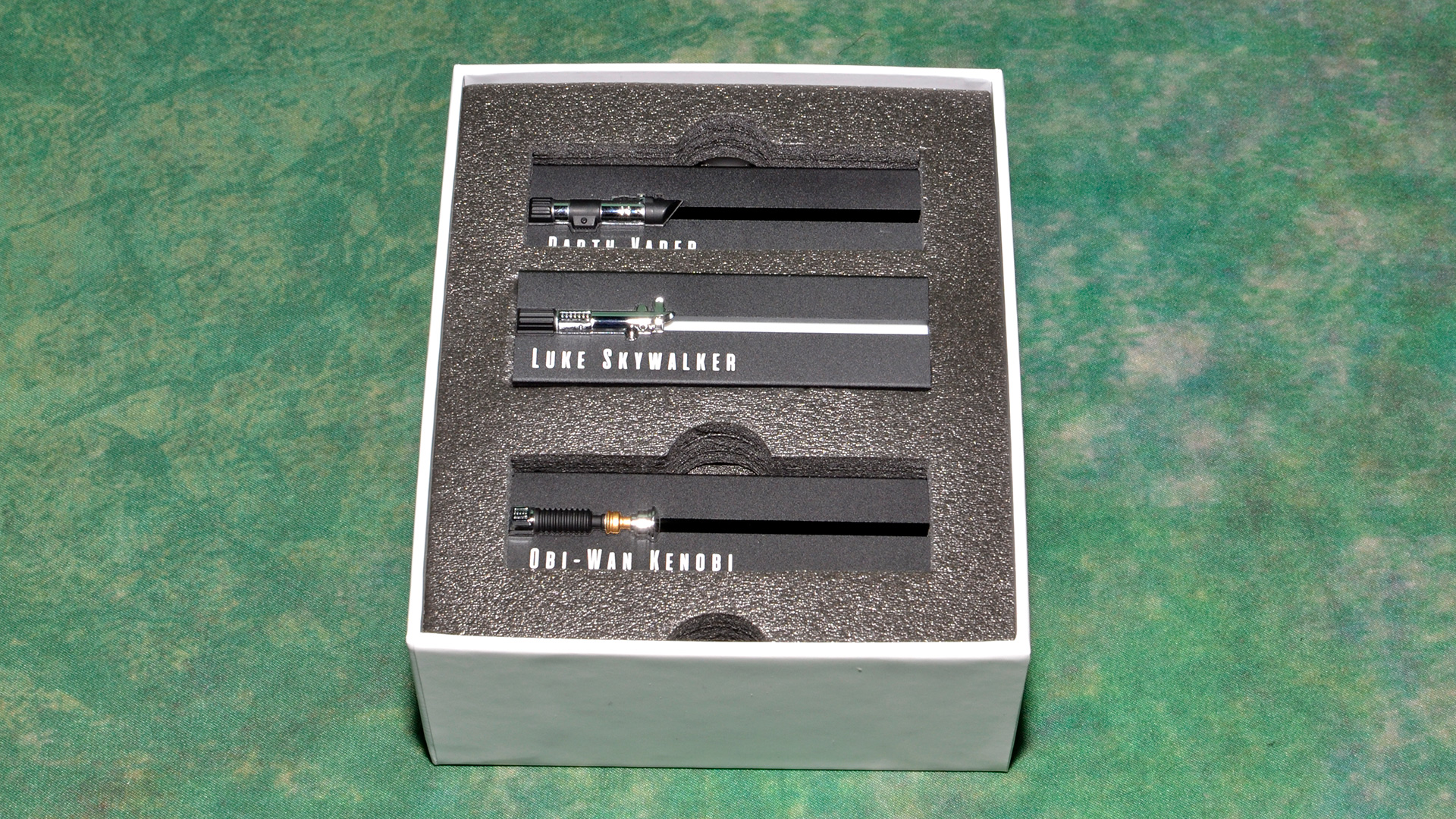

The Seagate Lightsaber SSD arrives in a comfortable box with three faceplates to use, including those of Obi-Wan Kenobi, Luke Skywalker, and Darth Vader, all officially licensed. Also included is a 40cm, or almost 16”, LED RGB connector cable. This cable lets you control the addressable RGB (ARGB) lightning with a wide array of RGB software applications.
The drive is clad in an effective heatsink crafted by EKWB, the same company that helped with the Seagate FireCuda 530 that forms the basis of this drive, although the design is different.
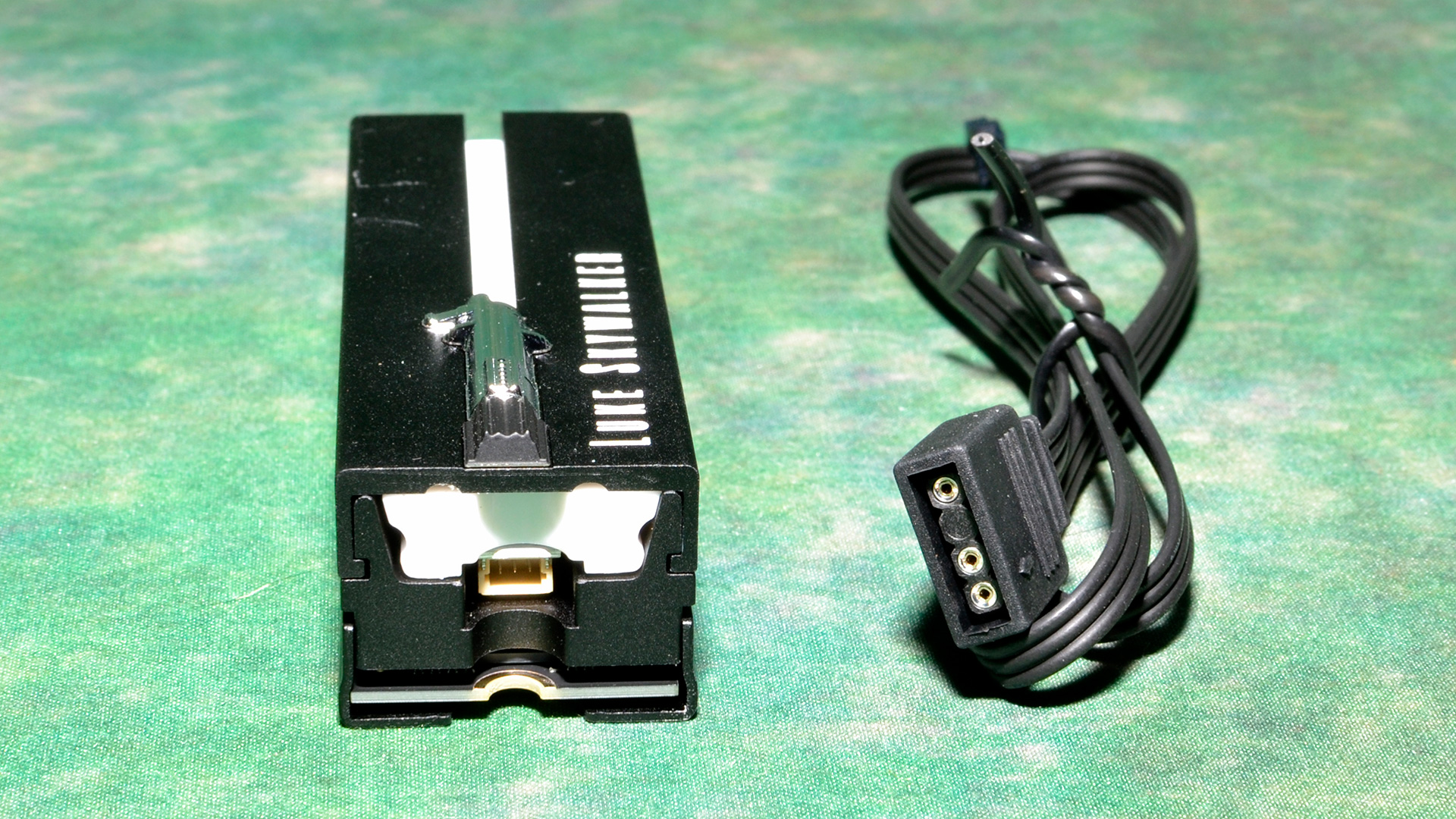


The LED bar is thick underneath, but otherwise no surprises. This drive still uses the Phison E18 SSD controller, 176-Layer Micron TLC (B47R), and DDR4 memory. This drive is double-sided with two DRAM and eight NAND packages. It has the standard 2GB of DRAM, and at 2TB, there is an excellent amount of flash for interleaving, so that’s where the drive reaches its peak performance.
MORE: Best SSDs
MORE: Best External SSDs and Hard Drives
MORE: How We Test HDDs And SSDs
MORE: All SSD Content
Comparison Products
Some things have changed since our Seagate FireCuda 530 review, so the Star Wars variant of the drive faces some new challengers, including the PCIe 5.0 Crucial T700. It’s also up against the original FireCuda 530, the Samsung 990 Pro, the Solidigm P44 Pro, the WD Black SN850X, the Sabrent Rocket 4 Plus-G, the Crucial P5 Plus, the Adata Legend 960 Max, amd the Corsair MP600 Core XT. All of these drives are high-end PCIe 4.0 except for the last, which is a mid-range, QLC-based part.
Trace Testing - 3DMark Storage Benchmark
Built for gamers, 3DMark’s Storage Benchmark focuses on real-world gaming performance. Each round in this benchmark stresses storage based on gaming activities including loading games, saving progress, installing game files, and recording gameplay video streams.



The Lightsaber FireCuda performs the same as the original FireCuda 530, as expected. Results are mediocre, including against the DirectStorage-optimized Rocket 4 Plus-G.
Trace Testing – PCMark 10 Storage Benchmark
PCMark 10 is a trace-based benchmark that uses a wide-ranging set of real-world traces from popular applications and everyday tasks to measure the performance of storage devices.
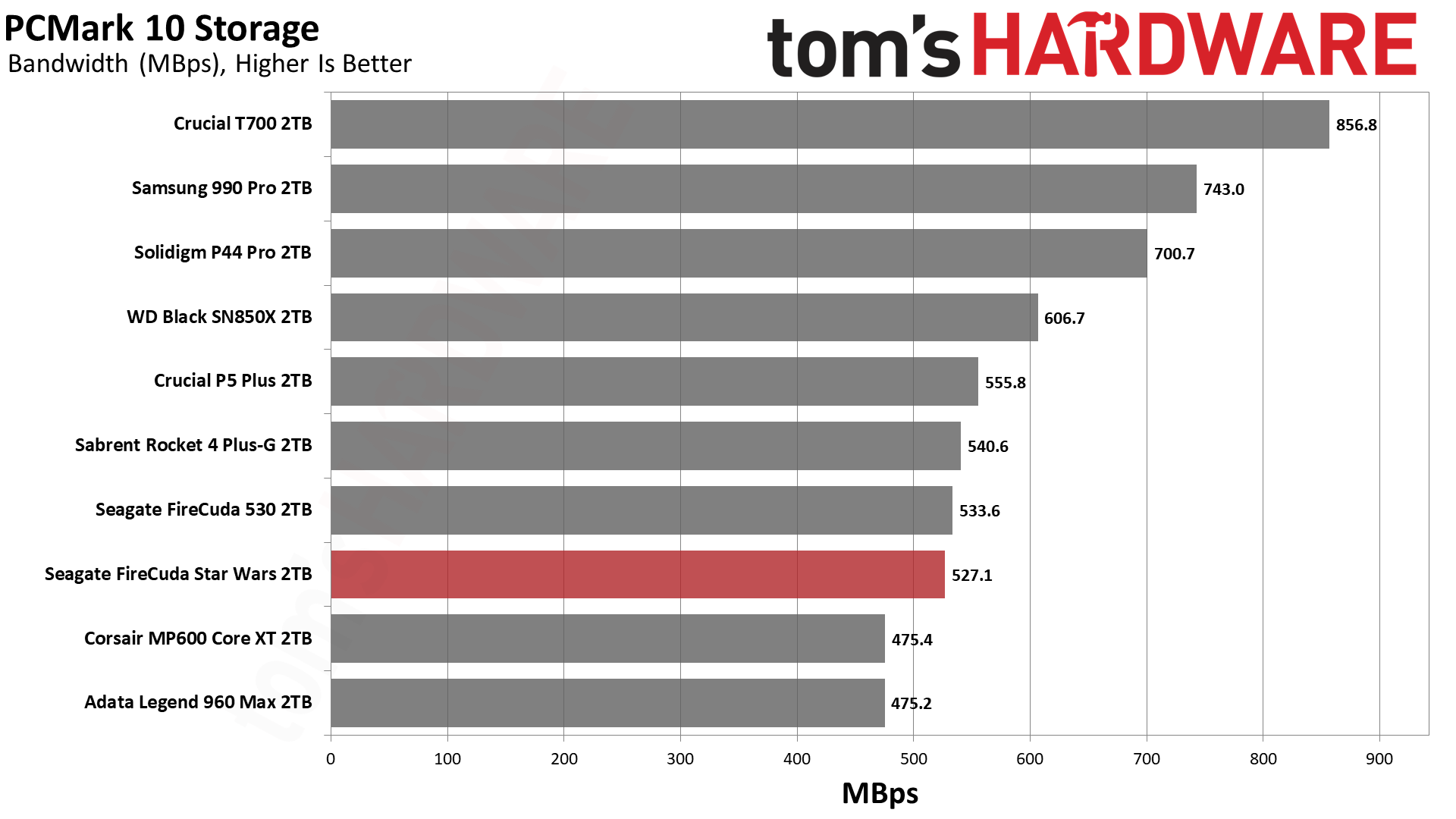

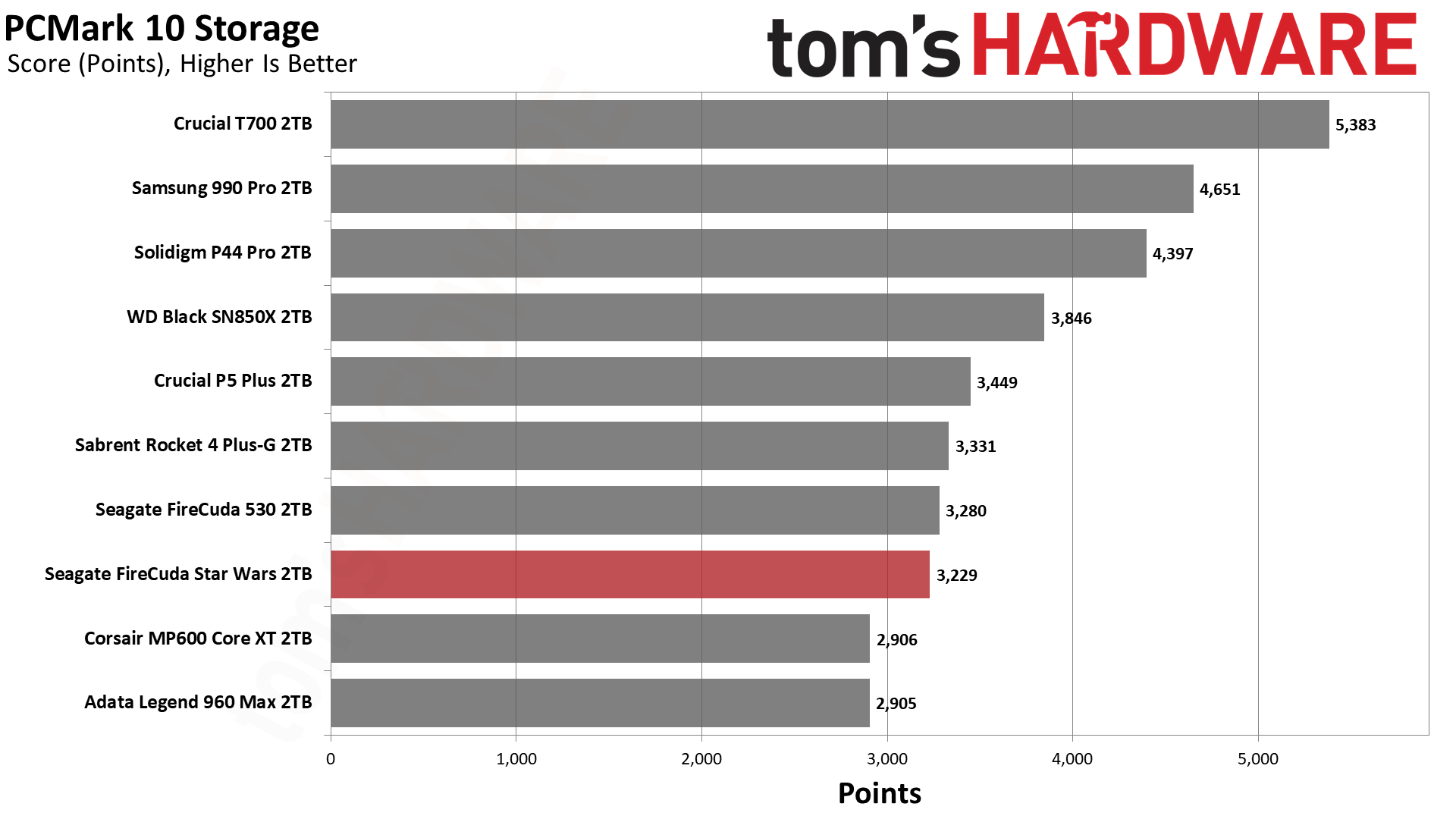
The Lightsaber FireCuda shows its age, losing out to fresher PCIe 4.0 SSDs, aside from the Legend 960 Max and MP600 Core XT.
Transfer Rates – DiskBench
We use the DiskBench storage benchmarking tool to test file transfer performance with a custom, 50GB dataset. We copy 31,227 files of various types, such as pictures, PDFs, and videos to a new folder and then follow-up with a reading test of a newly-written 6.5GB zip file.
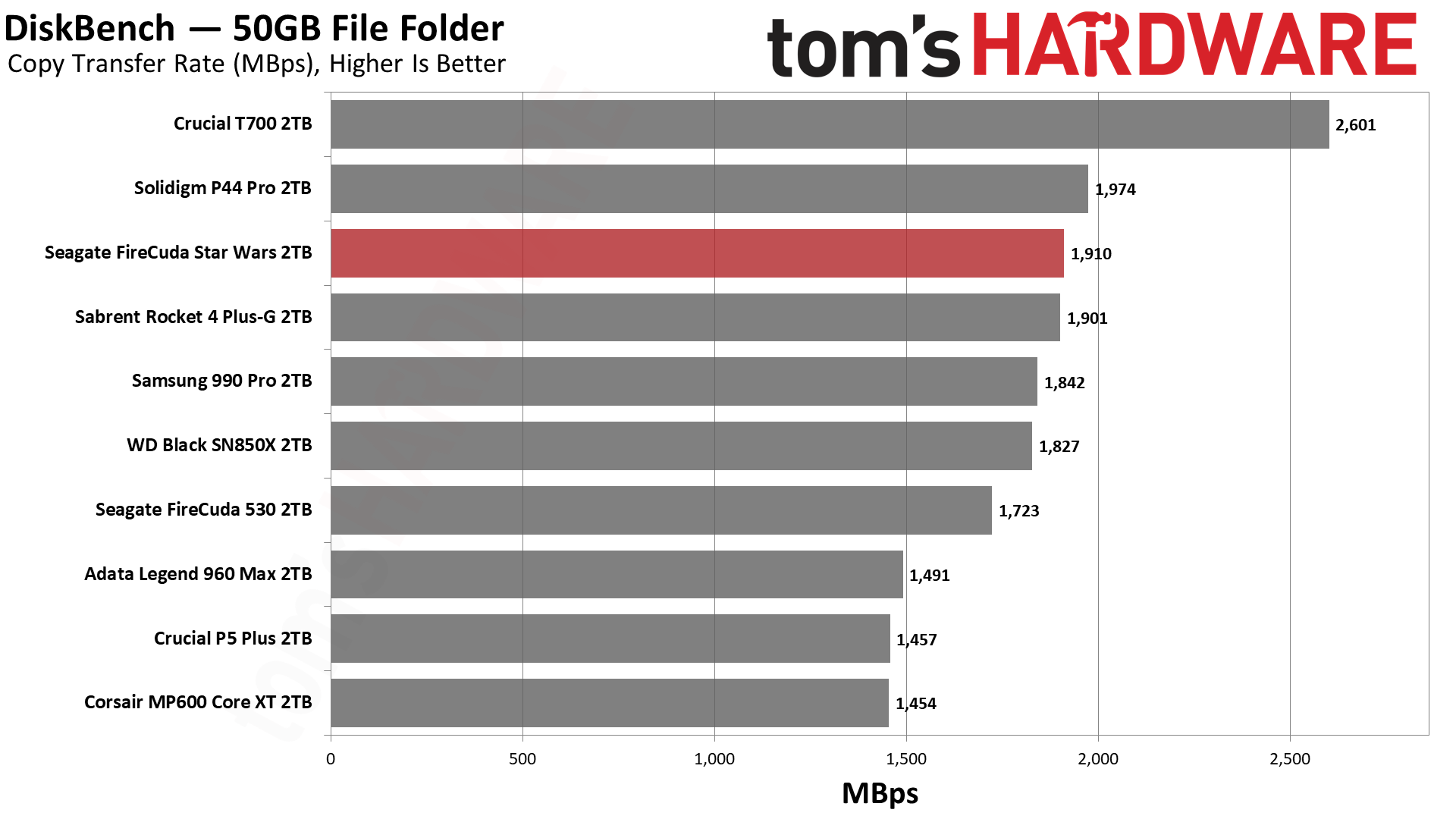

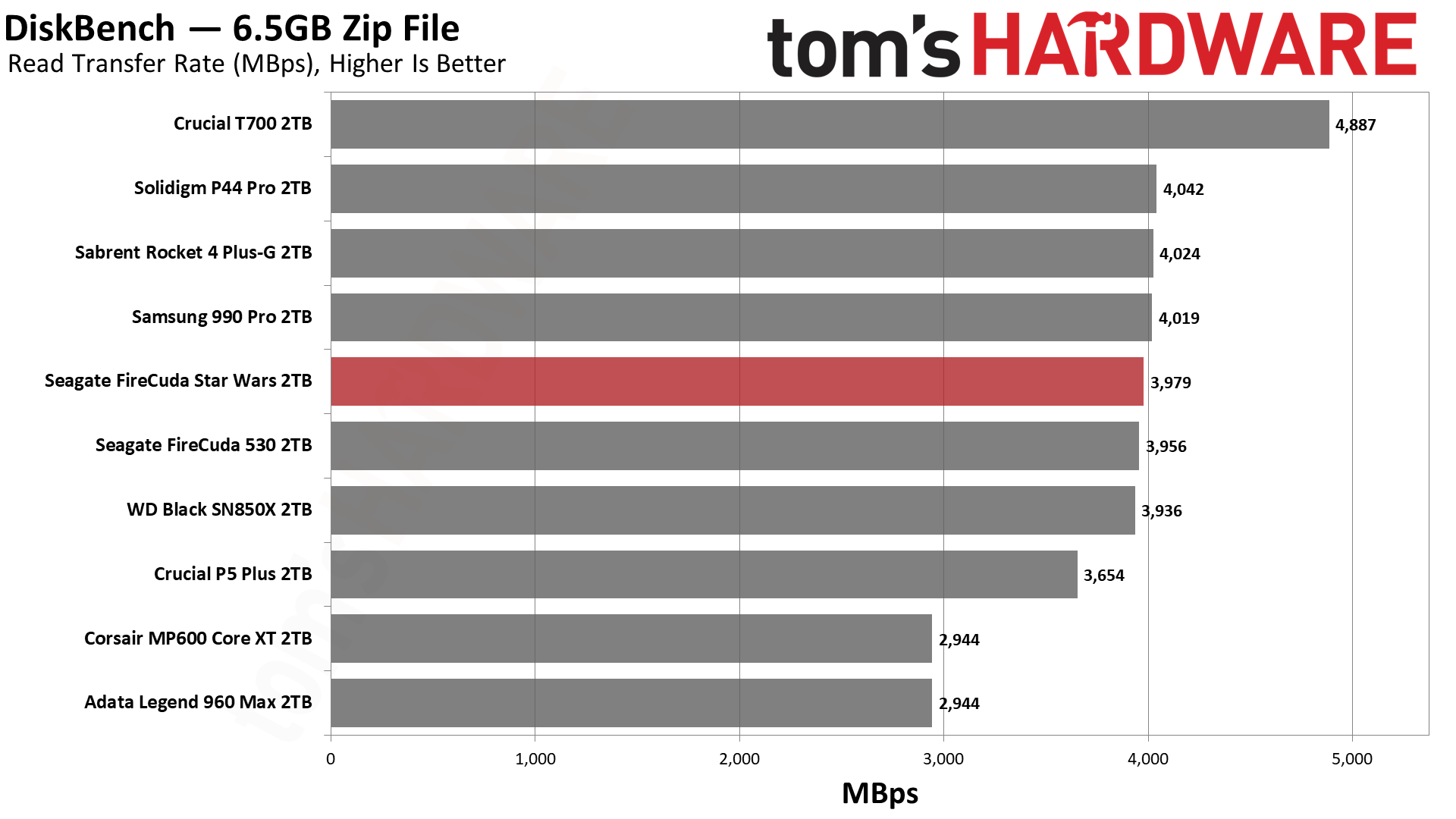
The Lightsaber FireCuda copies fairly fast, within striking distance of the P44 Pro. All drives fall behind the might of the PCIe 5.0 Crucial T700.
Synthetic Testing - ATTO / CrystalDiskMark
ATTO and CrystalDiskMark (CDM) are free and easy-to-use storage benchmarking tools that SSD vendors commonly use to assign performance specifications to their products. Both of these tools give us insight into how each device handles different file sizes.












The Lightsaber FireCuda shines brighter in ATTO, which is unsurprising as SSDs powered by Phison controllers perform well in this benchmark. It’s also clear to see that the PCIe 5.0 Crucial T700 pulls away from the pack. Sequential performance in CDM is fairly good on the Lightsaber FireCuda, aside from QD1 sequential reads, where the FireCuda 530 is even worse. The T700 dominates here, too.
Turning to random performance, the Lightsaber FireCuda manages to hang with the crowd but can’t quite reach the 990 Pro and T700 when it comes to 4K random reads at QD1. This is a key metric used to estimate real-world performance and feel, and the 990 Pro’s faster flash is still unbeatable.
Sustained Write Performance and Cache Recovery
Official write specifications are only part of the performance picture. Most SSDs implement a write cache, which is a fast area of (usually) pseudo-SLC programmed flash that absorbs incoming data. Sustained write speeds can suffer tremendously once the workload spills outside of the cache and into the "native" TLC or QLC flash.
We use Iometer to hammer the SSD with sequential writes for 15 minutes to measure both the size of the write cache and performance after the cache is saturated. We also monitor cache recovery via multiple idle rounds.


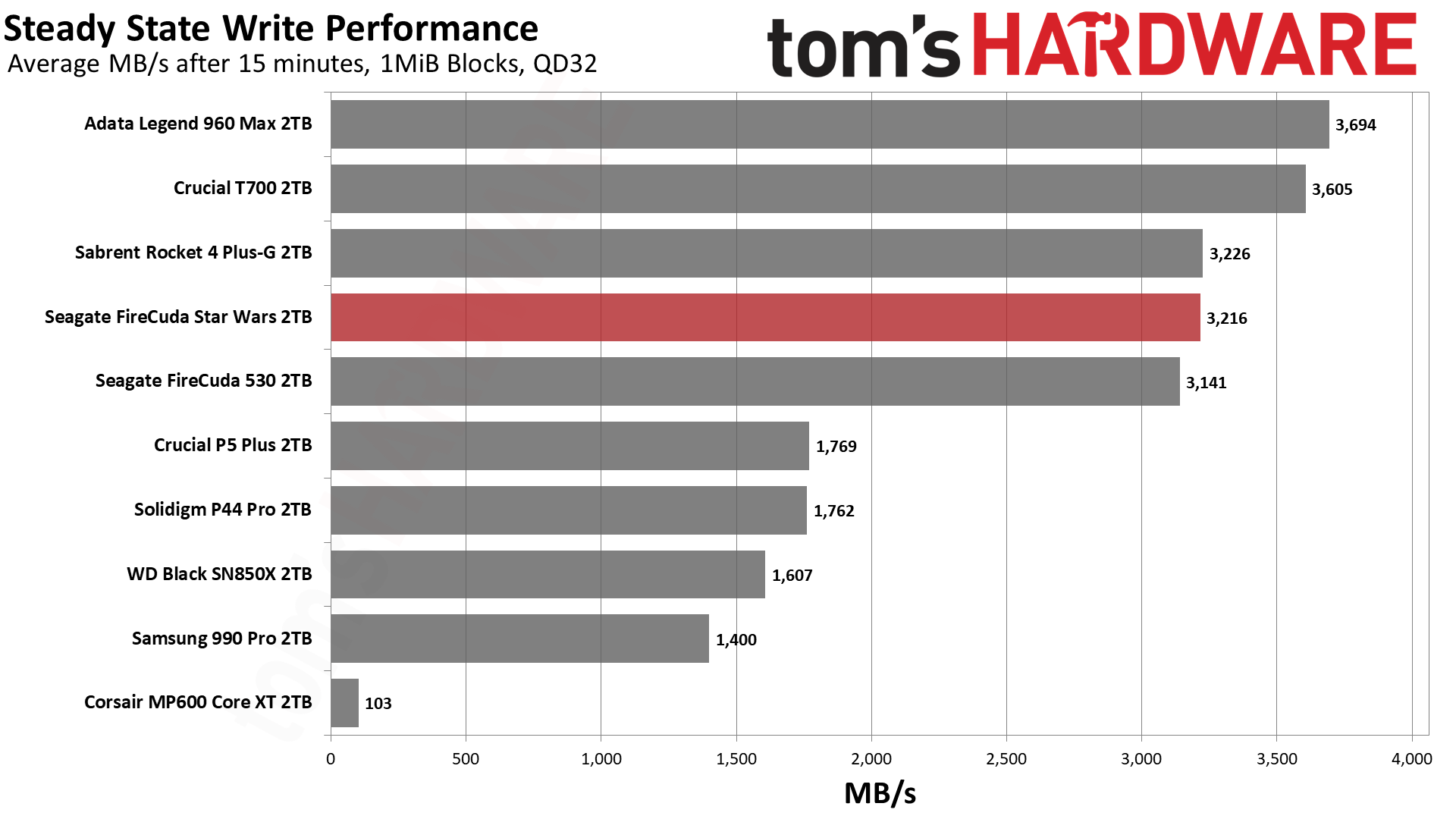
The original FireCuda 530 was one of the most consistent SSDs we’ve tested, thanks to its conservative pSLC cache. The Lightsaber FireCuda is virtually identical. It writes in pSLC mode at up to 6.9 GBps for over 30 seconds with a cache size of around 225GB. The write speed then declines to about 3.8 GBps in TLC mode, fast enough that it eventually reduces to folding at less than half that speed.
This is a good result with the Lightsaber FireCuda getting close to the Rocket 4 Plus-G at steady state, the latter drive among the fastest we’ve tested aside from the Legend 960 Max and T700. This makes the drive a good option for certain heavier workloads. pSLC recovery time to TLC performance levels is also good, but recovery to maximum speed takes longer. Avoiding additional writes and letting sequential writes hit TLC can be beneficial for reducing unnecessary wear, which can help support the high TBW rating.
Power Consumption
We use the Quarch HD Programmable Power Module to gain a deeper understanding of power characteristics. Idle power consumption is an important aspect to consider, especially if you're looking for a laptop upgrade as even the best ultrabooks can have mediocre storage.
Some SSDs can consume watts of power at idle while better-suited ones sip just milliwatts. Average workload power consumption and max consumption are two other aspects of power consumption, but performance-per-watt is more important. A drive might consume more power during any given workload, but accomplishing a task faster allows the drive to drop into an idle state more quickly, ultimately saving energy.




The Lightsaber FireCuda is surprisingly efficient, although far from the best. Using the LEDs should not be a concern, and this drive is adequately cooled. It’s precluded from being used in a laptop due to the heatsink, and the same is true of the PlayStation 5, although you wouldn’t be able to see the lightsaber in those cases, anyway.
Test Bench and Testing Notes
We use an Alder Lake platform with most background applications such as indexing, Windows updates, and anti-virus disabled in the OS to reduce run-to-run variability. Each SSD is prefilled to 50% capacity and tested as a secondary device. Unless noted, we use active cooling for all SSDs.
Bottom Line
The Seagate FireCuda Lightsaber SSD is merely an average performer within the high-end PCIe 4.0 array of SSDs, yet it easily stands out by its appearance. It arrives in thoughtful and tasteful packaging with an unambiguous Star Wars aesthetic, and who doesn’t love lightsabers? However, that’s mostly what this is - an SSD for Star Wars fans to show off in their desktop builds. The pricing reflects that and it’s essentially a collector’s item, which is perfectly fine. You can go with a cheaper drive and even design your own solution if you can’t find one of these.
Of perhaps greater contention is the focus on RGB LEDs. Historically, LEDs have had a rough road with SSDs. The Kingston HyperX Fury RGB SSD was prone to overheating due to using so many LEDs. Other drives, like the Patriot Viper VPR100, saw potential performance drops depending on the RGB mode. We had no issues with the Adata XPG Spectrix S40G, which like the Lightsaber FireCuda, has addressable RGB. However, RGB, in general, is a meme for flashy builds, and it’s not uncommon to have issues getting RGB software to behave.
It’s not really fair to compare this drive to other standard SSDs, as it’s designed for a specific purpose unrelated to its performance. However, it is generally fast enough to be “fast,” and the heatsink plus high sustained performance make it good for a wide range of applications. It’s possible to get an equivalent-performing SSDs and embellish it yourself, if you desire to get the right aesthetic. The Lightsaber FireCuda’s design won’t match all builds, even with the RGB LEDs. On the other hand, the inclusion of three faceplates means that you don’t have to settle for one specific Star Wars hero’s lightsaber.
On the whole, this is a cool drive, even if it comes from Seagate, a storage company that hasn’t really gotten deep into the SSD game. It would be interesting to see how well its data recovery service works with SSDs. It is nice to know that your expensive lightsaber SSD is backed by something a little extra. Aside from that, the biggest downside is dealing with the cable. If that’s not an issue for you and you can find this drive, it could be a worthwhile grab.
MORE: Best SSDs
MORE: Best External SSDs and Hard Drives
MORE: How We Test HDDs And SSDs
MORE: All SSD Content







